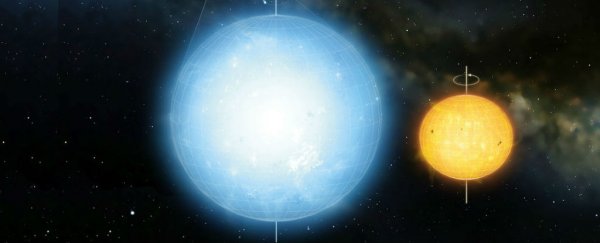Key Takeaways:
- Scientists have identified Kepler 11145123, a star located 5,000 light-years away, as the most spherical natural object ever measured.
- This astonishing discovery challenges conventional understanding of celestial bodies, as the star’s roundness surpasses even that of the Sun.
- The groundbreaking technique of asteroseismology was employed to precisely assess the star’s shape, revealing its remarkably low oblateness.
- Despite its slow rotation, Kepler 11145123 defies expectations by being even less flattened than suggested by its sluggish spin rate.
- The researchers speculate that a magnetic field near the star’s low latitudes may be a key factor influencing its unparalleled roundness.

Geometry permeates the natural world, manifesting in the mesmerizing symmetries of snowflakes, the intricate fractals of broccoli, and the spiraling patterns of Fibonacci found in red cabbage. However, a perfectly spherical object is a rarity in the realm of nature.
Amidst the countless celestial bodies populating the cosmos, it is common for stars, moons, and planets to appear spherical. Yet, the truth is that their rotations cause them to experience flattening, squishing, and distortion. Remarkably, scientists have identified a star that defies this trend, standing as the most spherical object known to humanity.
This extraordinary star bears the name Kepler 11145123, or KIC 11145123, and resides a staggering 5,000 light-years from our home planet. When initially discovered by a team led by astronomer Laurent Gizon from the Max Planck Institute for Solar System Research and the University of Göttingen in Germany, a cutting-edge technique called asteroseismology was employed to precisely gauge its degree of roundness.
Kepler 11145123, a slowly rotating sphere of gas, astonishes researchers by retaining its perfect spherical shape throughout its rotation. In fact, experts assert that it surpasses the roundness of even our radiant Sun, marking it as the most spherical natural object ever quantified.
Asteroseismology, a method that enables the calculation of star oscillations, was pivotal in determining the star’s oblateness – a measure of how much a circle or sphere is flattened or compressed. As celestial objects spin on their axes, they contend with centrifugal forces that tug their equatorial regions away from the center of rotation, resulting in a slight “oblate” shape.
In contrast, Kepler 11145123 is an exceptionally leisurely spinner, rotating at a mere one-third the speed of our Sun while boasting a size more than double. Astonishingly, the discrepancy between the star’s equatorial and polar radii is a mere 3 kilometers, a striking contrast to its average radius of 1.5 million kilometers.
Curiously, the star’s level of flatness appears to contradict the anticipated effect of its leisurely rotation rate. The research suggests that the star’s exterior layers rotate at a faster pace than its core, a disparity that contributes to its unusually round shape.
The cause of this divergence in surface and core spin rates remains a mystery, though the researchers speculate that a magnetic field surrounding the star’s low latitudes may hold the key.
They posit that, aside from a magnetic field, there are scarce alternative explanations for the star’s reduced oblateness. This remarkable discovery may prompt a closer examination of the physics governing stellar oscillations.
Looking ahead, the team plans to extend their groundbreaking technique to other stars, probing how rotations and magnetic fields may influence their shapes. The study, which unveils the enigma of the universe’s most perfect sphere, has been published in Science Advances.


